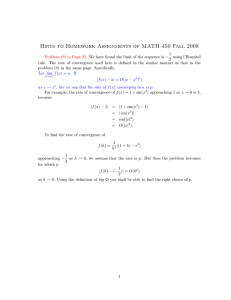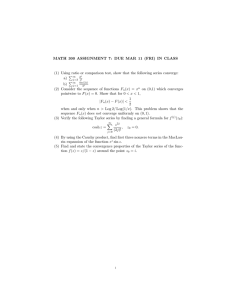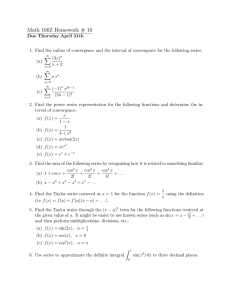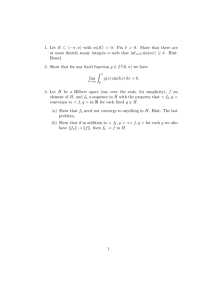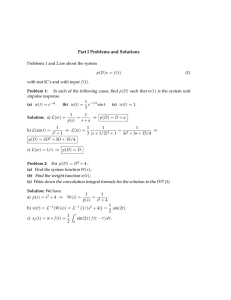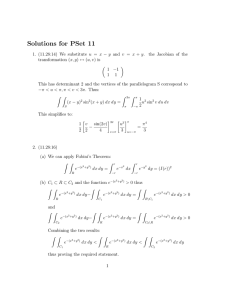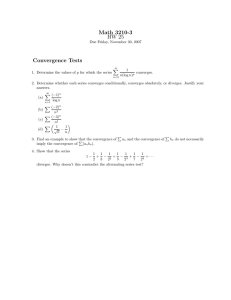Answ ers to Problem
advertisement
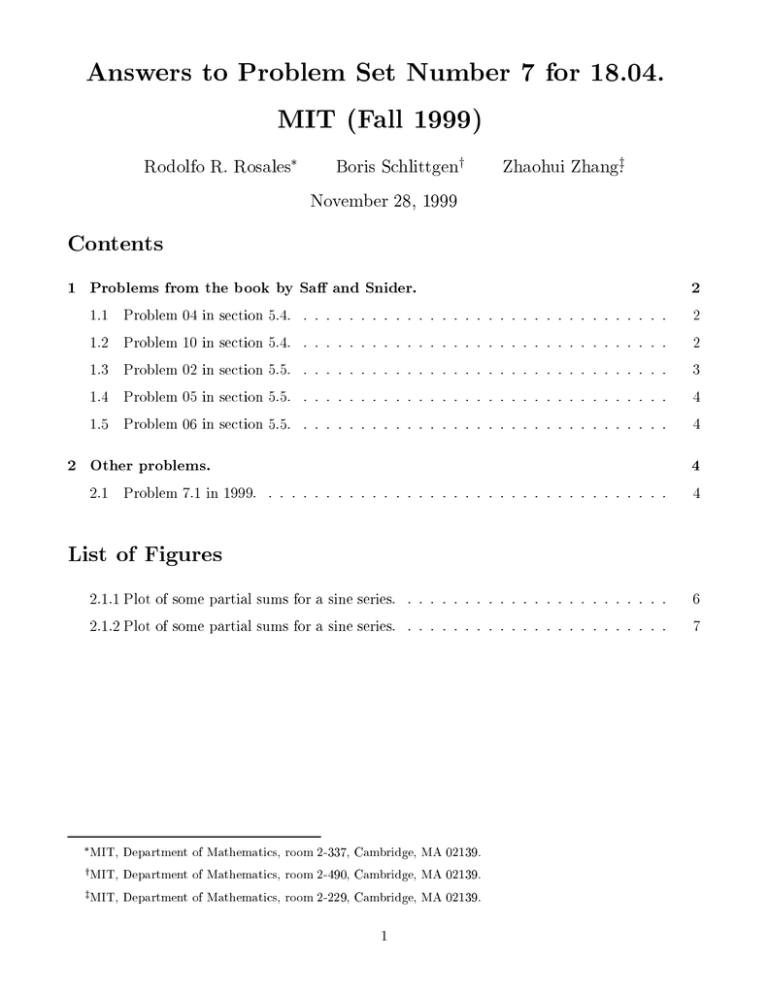
Answers to Problem Set Number 7 for 18.04.
MIT (Fall 1999)
Rodolfo R. Rosales
Boris Schlittgen
y
z
Zhaohui Zhang.
November 28, 1999
Contents
1 Problems from the book by Sa and Snider.
2
1.1 Problem 04 in section 5.4. . . . . . . . . . . . . . . . . . . . . . . . . . . . . . . . .
2
1.2 Problem 10 in section 5.4. . . . . . . . . . . . . . . . . . . . . . . . . . . . . . . . .
2
1.3 Problem 02 in section 5.5. . . . . . . . . . . . . . . . . . . . . . . . . . . . . . . . .
3
1.4 Problem 05 in section 5.5. . . . . . . . . . . . . . . . . . . . . . . . . . . . . . . . .
4
1.5 Problem 06 in section 5.5. . . . . . . . . . . . . . . . . . . . . . . . . . . . . . . . .
4
2 Other problems.
4
2.1 Problem 7.1 in 1999. . . . . . . . . . . . . . . . . . . . . . . . . . . . . . . . . . . .
4
List of Figures
2.1.1 Plot of some partial sums for a sine series. . . . . . . . . . . . . . . . . . . . . . . .
6
2.1.2 Plot of some partial sums for a sine series. . . . . . . . . . . . . . . . . . . . . . . .
7
MIT,
Department of Mathematics, room 2-337, Cambridge, MA 02139.
y MIT,
Department of Mathematics, room 2-490, Cambridge, MA 02139.
z MIT,
Department of Mathematics, room 2-229, Cambridge, MA 02139.
1
18.04 MIT, Fall 1999 (Rosales, Schlittgen and Zhang).
Answers to Problem Set # 7.
2
1 Problems from the book by Sa and Snider.
1.1
Problem 04 in section 5.4.
Part (a):
.
2
j =1 j
Clearly, the radius of convergence for this series is 1. Notice now that, for jz j 1 we have
1
X
jzj =j 2j (1=j 2). Furthermore, the series of real numbers j 2 converges. Thus, by the Weierj =1
strass M-test,
1 zj
X
converges uniformly on the closed disc jz j 1 :
2
j =1 j
That is: in this example the series converges everywhere on its circle of convergence jz j = 1.
1 zj
X
.
Part (b): The series:
j =1 j
1
X
Again, the radius of convergence is 1. Now: when z = 1, the series
j 1 does not converge (by
j =1
1
X
the integral test), and when z = 1, the series ( 1)j j 1 does converge (by the alternating series
j =1
test). Thus, in this example the series converges for some points on its circle of convergence (at
least for z
The series:
1 zj
X
= 1)
Part (d):
and diverges for others (at least for z
The series:
1
X
= 1).
zj .
j =1
Again, this series has a radius of convergence equal to 1. When jz j = 1, we notice that the sequence
1
X
jzj j does not converge to 0 (since all of its terms are equal to 1). Therefore the series zj cannot
j =1
converge when jz j = 1. Thus, in this example the series does not converge at any of the points on
its circle of convergence.
1.2
Problem 10 in section 5.4.
For the Fibonacci numbers, we know that a0 = a1 = 1 and
an
= an
1
+ an
Dene now1
f (z )
1 The
function
f
is known as the
generating
=
2
1
X
n=0
for n 2 :
an z n ;
function for the sequence.
(1.2.1)
18.04 MIT, Fall 1999 (Rosales, Schlittgen and Zhang).
Answers to Problem Set # 7.
3
where the coeÆcients an are given by the Fibonacci sequence. Multiplying (1.2.1) by z n and adding
over n we obtain: f (z )
a0
= zf (z )
a1 z
+ z 2 f (z ). That is
a0 z
1 + (z 2 + z
1)f (z ) = 0:
Let us double check this:
1
X
1 + zf (z ) + z 2 f (z ) = 1 +
n=0
1
X
= 1+
k=1
an z n+1
ak
1z
= 1 + a0 z +
+
k+
1
X
1
an z n+2
X
n=0
1
X
k=2
(ak
1
ak
2z
k
+ ak 2 )z k
k=2
1
1
X
= 1 + z + ak z k =
ak z k = f (z ) :
k=2
k=0
We can solve this for f (z ) and then do a partial fraction decomposition, to obtain
X
f (z )
=
=
=
=
1
1
z
z2
=
1
z
+1
p5 z
2
p + 1+2 5
2
p 1 2p 5 1+ 5
1 + (1+ 5) z
p
p
p
p1 (1 2 5) 5
1
1
1
p
p
1= 5
1= 5
p +
p =
1+ 5
z+ 2
z+1 2 5
2
p 5 1
5
1
1 + (1 2p5) z
p
1 (1 + 5)
p5 + p 2
5
z
1
2
1
p
1+ 5
2
z
p X
p !n
p 1
p !n
5 1 1
5
1 1
1 1+ 5 X
1+ 5
n
p 2
z +p zn
2
2 n=0
2
5
5
n=0
p !n+1
1 1
1+ 5
4
p
=
2
n=0 5
2
X
1
p
2
5
n
! +1 3
5
zn ;
which proves the desired result. Here we have used: the geometric series expansion and the fact
p
2
1
5
p =
that
.
2
(1 + 5)
1.3
Problem 02 in section 5.5.
The principal branch of
pz has a branch cut on the negative real axis, thus it is not analytic on
any annulus around the origin. Therefore, no Laurent series expansion exists in C
f0g.
In fact
18.04 MIT, Fall 1999 (Rosales, Schlittgen and Zhang).
no branch of
1.4
p
z
Answers to Problem Set # 7.
has a Laurent series expansion in the domain C
4
f0g.
Problem 05 in section 5.5.
(z + 1)
in a punctured disc of radius 4 around z0 = 4, let us rewrite
z (z 4)3
this expression so that we can use the geometric series:
To nd the Laurent series of
(z + 1)
1 1
=
1
+
z (z 4)3
(z 4)3
z
!!
1
1
1
1+ =
(z 4)3
4 1 + z44
1 z 4 n !
1
1X
=
1+
(z 4)3
4 n=0
4
1
X
1
1 k+4
=
(z 4)k :
(z 4)3 k= 3 4
In the last line we have made the substitution k = n
1.5
3.
Problem 06 in section 5.5.
To nd the Laurent series for z
1
in jz j > 0, we make use of the Taylor series for the cosine,
cos
3z
2
which we know well:
1 ( 1)n
2n :
cos( ) =
n=0 (2n)!
X
Thus
1 ( 1)n 1
2n
n=0 (2n)! (3z )
1 ( 1)n 1
X
=
z 2(1 n) :
2n
(2
n
)!
3
n=0
1
cos
=
3z
z
2
z2
X
2 Other problems.
2.1
Problem 7.1 in 1999.
Statement:
Find a formula for
f (x)
=
1
( 1)n
X
n=1
sin(nx)
n
;
(2.1.1)
18.04 MIT, Fall 1999 (Rosales, Schlittgen and Zhang).
where x is real and
5
Answers to Problem Set # 7.
x .
Write a short program to calculate and plot the sum of the series. In MatLab you could dene
an array of values in
x by:
x = {pi + 2*pi*(0:750)/750;
Then do a loop to sum (say) the rst 3000 terms:
f = 0;
for n = 3000:{1:1
f = f + (({1)^n)*(sin(n*x)/n);
end
Finally, plot:
plot(x, f)
Look at the plot. Can you get this from your formula?
Note: this series converges rather slowly (this is why I suggest a lot of terms in the summation).
This series is also a good example of a non-uniformly convergent series of functions. At any given
x,
the error after summing N terms is less than C (x)=N , but C (x) is not bounded.
The stu below is highly recommended; do it (although we will not grade it, since it is an
open-ended thing, what happens here is very important and it will show up later in the course).
To see how the convergence actually occurs, try plotting partial sums (as above), but instead of
looking at a lot of terms, look at what happens as you add (say) 10, 20, 50, 100, 150 terms.
carefully at what goes on near x
=
and x
=
.
Look
Now do the same for the series where the n-th
term is sin(nx)=n and look at what happens near x = 0.
1
X
sin(nx)
, we begin by recalling De Moivre's formula:
Solution: To sum the series f (x) =
( 1)n
n
n=1
einz = cos(nz ) + i sin(nz )
and the Taylor expansion for the principal branch of the logarithm about z = 1:
1 ( 1)n
X
Log(1 + z ) =
zn :
n
n=1
This leads us to consider
1
1
X
X
einx
sin(nx)
Log(1 + eix ) = ( 1)n
=) Im log(1 + eix ) = ( 1)n
:
n
n
n=1
n=1
(2.1.2)
(2.1.3)
18.04 MIT, Fall 1999 (Rosales, Schlittgen and Zhang).
6
Answers to Problem Set # 7.
Now, since Log(1 + eix ) = ln j1 + eix j + iArg(1 + eix ), we nally obtain:
1 ( 1)n
X
n=1
n
sin(nx) =
!
Arg(1 + eix ) =
tan
1
=
tan
1
=
tan
1
1
x:
2
=
The last equality here is valid only for
<x<
sin(x)
1 + cos(x)
!
2 sin(x=2) cos(x=2)
2 cos2 (x=2)
!
sin(x=2)
cos(x=2)
(outside this range dierent branches of tan
1
come into play). Obviously = Arg(1 + eix ) is periodic of period 2 and takes values only in the
range jj (this all agrees with the fact that the innite sum on the left should be periodic of pe2
1
riod 2 in x). Thus, for example, for < x < 3 the sum is equal to x and for 3 < x < 2
1
it is equal to x. The sum is (in fact) a sawtooth function and (2.1.1) is just its
2
Fourier Series.
Figures 2.1.1 and 2.1.2 show some partial sums for the series in (2.1.1).
Series sum. First 10 terms.
Series sum. First 50 terms.
1.5
Sum [ (-1) n sin(nx)/n ]
Sum [ (-1) n sin(nx)/n ]
1.5
1
0.5
0
-0.5
-1
1
0.5
0
-0.5
-1
-1.5
-1.5
-4
Notice that the convergence
-3
-2
-1
0
1
2
3
4
-4
-3
-2
x
-1
0
1
2
3
4
x
Figure 2.1.1: Plots of the partial sums with 10 and 50 terms for the innite series in (2.1.1).
to the limit is reasonable for
x
away from the discontinuities at
x
= n . Near the discontinuities
oscillations in the sums appear. These oscillations do not disappear as more terms are added to
18.04 MIT, Fall 1999 (Rosales, Schlittgen and Zhang).
Answers to Problem Set # 7.
Series sum. First 250 terms.
Series sum. First 250 terms.
1.5
sin(nx)/n ]
1.5
1
0.5
n
0
Sum [ (-1)
Sum [ (-1) n sin(nx)/n ]
7
-0.5
-1
-1.5
1
0.5
0
-0.5
-1
-1.5
-4
-3
-2
-1
0
1
2
3
4
2.9
2.95
3
3.05
x
3.1
3.15
3.2
3.25
x
Figure 2.1.2: Plot of the partial sum with 250 terms for the innite series in (2.1.1), with a blow up
of the region near the discontinuity at x = .
the sum. In fact, what happens is (let
series)
N be the number of terms added in the partial sum for the
that:
The amplitude of the oscillations remains constant, about 12% of the jump across the discontinuity.
The region over which the oscillations occur gets narrower, with its width
O (N
1
). This is
illustrated by the detail shown on the right picture in gure 2.1.2.
The fact that oscillation appear near discontinuities in the partial sums of Fourier Series (as described above) is general and it is known by the name of
Gibbs Phenomenon.
It is related to the fact that series such as (2.1.1) do not converge uniformly in x. You can experiment
more with Fourier Series and the Gibbs phenomenon using the MatLab scripts in the 18.04 Toolkit
in Athena (specically: GibbsDemo and sinSERIES).
Finally: an important clarications that we should make regarding the calculations here:
Generally we can only be sure of the convergence of a Taylor series inside its circle of convergence.
18.04 MIT, Fall 1999 (Rosales, Schlittgen and Zhang).
Answers to Problem Set # 7.
However, above in (2.1.3) we used the Taylor series (2.1.2) for Log(1 + z )
right on
8
its circle of
convergence! This needs some justication:
We show now that the Taylor series (2.1.2) converges everywhere in its circle of convergence, except
for z
= 1 (but the convergence is not uniform). We start with the formula for the partial sums of
the geometric series
N
1 + ( 1)N N +1
:
1+
0
Integrate now both sides in this equality along the path = rz in the complex {plane, where
( 1)n n =
X
0 r 1 and z 6= 1 is some arbitrary point with jz j 1. This yields:
NX
+1
( 1)n n
z
=
1
Z 1
n
0
1 + ( 1)N z N +1 rN +1
zdr
1 + rz
Z 1
=
0
z
1 + rz
dr + ( 1)N z N +2
= Log(1 + z ) + ( 1)N z N +2
Z 1
Z 1
0
0
r N +1
1 + rz
r N +1
1 + rz
zdr
zdr :
9
>
>
>
>
>
>
>
>
>
>
>
>
=
>
>
>
>
>
>
>
>
>
>
>
>
;
(2.1.4)
Now, because jz j 1 and z 6= 1, it follows that: j1 + rz j M = M (z ) for 0 r 1; where
M (z ) >
0 (though
(2.1.4) by:
M
vanishes as
z
!
1). Thus we can estimate the size of the last term in
r N +1
zdr rz
1
:
(N + 2)M
0 1 +
0
Using this in (2.1.4), we see that the sum on the left converges to Log(1 + z ) as N
( 1)N z N +2
Z 1
1
M
Z 1
r N +1 dr
=
is what we set out to prove.
Notice that the estimate in (2.1.5) is not uniform in z , since
M
(2.1.5)
! 1 | which
vanishes for z ! 1. Thus the
convergence of the Taylor series degrades as we approach z = 1.
Remark 2.1.1
In the problem statement it was mentioned that the series in (2.1.1) did not converge
uniformly, with an error on the partial sums of the form C (x)=N , where C was not bounded.
Applying the results of the proof above to z
| with C
=
1
.
M (eix )
= eix
and using (2.1.3), we see that this result follows
THE END.
